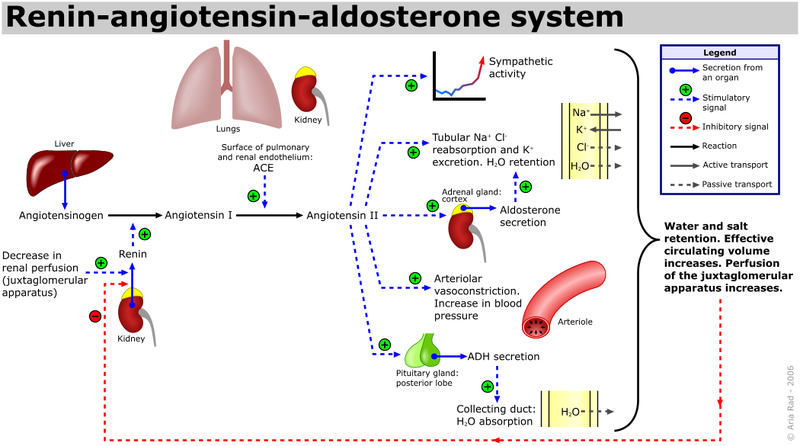Figure: Courtesy, A. Rade; Physiology
One mechanism for maintaining the blood pressure is the release of a protein called renin from cells in the kidney (to be specific, the juxtaglomerular apparatus). This produces another protein, angiotensin, which signals the adrenal gland to produce a hormone called aldosterone.
This system is activated in response to a fall in blood pressure (hypotension), as well as markers of problems with the salt-water balance of the body, such as decreased sodium concentration in the distal tubule of the kidney, decreased blood volume and stimulation of the kidney by the sympathetic nervous system.
In such situations, the kidneys release renin, which acts as an enzyme and cuts off all but the first 10 amino acid residues of angiotensinogen (a protein made in the liver, and which circulates in the blood). These 10 residues are then known as angiotensin I. Angiotensin converting enzyme (ACE) then removes a further two residues which converts angiotensin I into angiotensin II. Angiotensin II is found in the pulmonary circulation, as well as in the endothelium of many blood vessels. The system in general aims to increase blood pressure by increasing the amount of salt and water the body retains, although angiotensin is also very good at causing the blood vessels to tighten (a potent vasoconstrictor). Angiotensin II also stimulates the secretion of the hormone aldosterone from the adrenal cortex.
Aldosterone causes the tubules of the kidneys to increase the reabsorption of sodium and water into the blood. This increases the volume of fluid in the body, which also increases blood pressure.
Biologists Try to Know, "What the life is!" Biology came into being since Life appeared on earth... You can find here Biological Concepts, Solved Question Papers For Free, Unsolved Science Mysteries and Important General Definitions Which Usually Appear In Exams.
Thursday, 2 August 2012
What are Protists?
Definition of Protists:
The unicellular or simple multicellular eukaryotic organisms which are not produced from an embryo (blastula) are called protists. Protists are of three major types:
i. Animal like, the Protozoans
ii. Plant like, algae
iii. Fungus like, Slime Molds and Water Molds.
Some Questions and Their Answers About Protists:
Q1. What are Protozoans?
Ans: The unicellular ingesting organisms (protists) are called Protozoans e.g; Amoeba, Paramecium etc.
Q2. What are algae?
Ans: The unicellular or simple multicellular photo-autotraphs which do not produce an embryo are called algae.
Q3. How algae are similar to plants?
Ans. Both algae and plants have cell wall made up of cellulose. Both have similar chloroplast.
The unicellular or simple multicellular eukaryotic organisms which are not produced from an embryo (blastula) are called protists. Protists are of three major types:
i. Animal like, the Protozoans
ii. Plant like, algae
iii. Fungus like, Slime Molds and Water Molds.
Some Questions and Their Answers About Protists:
Q1. What are Protozoans?
Ans: The unicellular ingesting organisms (protists) are called Protozoans e.g; Amoeba, Paramecium etc.
Q2. What are algae?
Ans: The unicellular or simple multicellular photo-autotraphs which do not produce an embryo are called algae.
Q3. How algae are similar to plants?
Ans. Both algae and plants have cell wall made up of cellulose. Both have similar chloroplast.
Subscribe to:
Posts (Atom)
